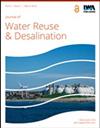Effects of chlorine disinfection on RO membrane biofouling at low feed water temperature for wastewater reclamation
IF 2.3
Q2 Environmental Science
引用次数: 4
Abstract
Chlorine disinfection has been reported to be ineffective in controlling RO membrane biofouling in some projects. Feed water temperature is a crucial factor in the formation of RO membrane biofouling. It has a positive impact on the wide application of the RO process to ascertain whether chlorine disinfection can alleviate the membrane biofouling at low temperatures. In this study, the effects of chlorination on the RO membrane biofouling at low feed water temperature (10 °C) were investigated by a lab-scale RO apparatus. The final normalized flux was 0.33 and 0.29 with and without chlorination, respectively. According to the normalized flux decline curve, chlorination could not alleviate the RO membrane fouling at low temperature. Based on the intermediate blocking model, chlorination increased the membrane fouling potential of the feed water. At low temperature, the biofilm on the membrane with chlorination was thinner and denser than that without chlorination. In addition, the membrane with chlorination contained more foulants and dissolved organic matter than that without chlorination. Chlorination failed to continuously prevent bacteria accumulation on RO membrane at low temperature, but screened out bacteria that were potentially more suitable for the low-temperature membrane environment.氯消毒对低进水温度RO膜生物结垢的影响
据报道,氯消毒在某些工程中对反渗透膜生物污染的控制效果不佳。进水温度是反渗透膜生物污染形成的关键因素。确定氯消毒是否能缓解低温下膜生物污染对反渗透工艺的广泛应用具有积极的影响。在实验室规模的反渗透装置上,研究了在低进水温度(10°C)下,氯化对反渗透膜生物污染的影响。加氯和不加氯的最终归一化通量分别为0.33和0.29。由归一化通量下降曲线可知,在低温条件下,氯化处理不能缓解反渗透膜的污染。基于中间堵塞模型,加氯增加了给水的膜污染电位。低温下,加氯处理后的膜上生物膜比未加氯处理的膜更薄、密度更大。此外,加氯处理后的膜比未加氯处理的膜含有更多的污染物和溶解性有机物。在低温条件下,氯化不能持续阻止细菌在反渗透膜上的积聚,反而筛选出了可能更适合低温膜环境的细菌。
本文章由计算机程序翻译,如有差异,请以英文原文为准。
求助全文
约1分钟内获得全文
求助全文
来源期刊

Journal of Water Reuse and Desalination
ENGINEERING, ENVIRONMENTAL-WATER RESOURCES
CiteScore
4.30
自引率
0.00%
发文量
23
审稿时长
16 weeks
期刊介绍:
Journal of Water Reuse and Desalination publishes refereed review articles, theoretical and experimental research papers, new findings and issues of unplanned and planned reuse. The journal welcomes contributions from developing and developed countries.
 求助内容:
求助内容: 应助结果提醒方式:
应助结果提醒方式:


